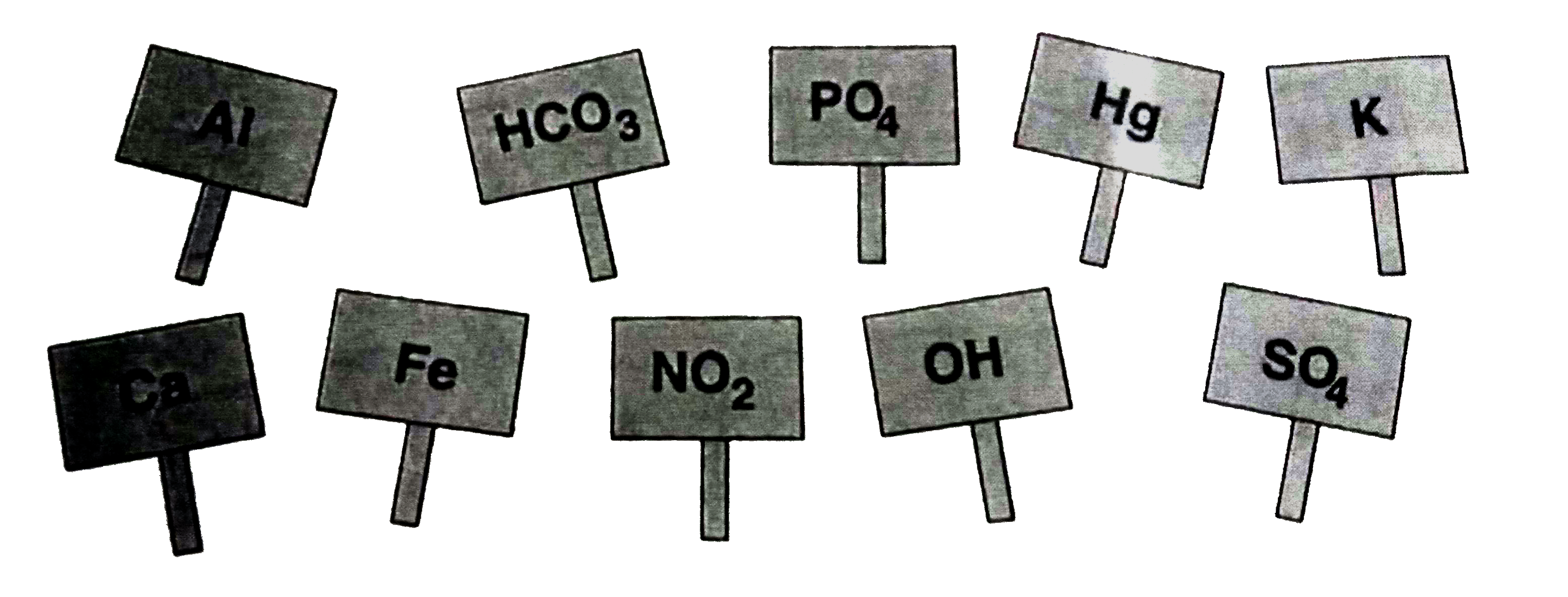(a)Give one point of difference betweeen an atoms and an ion.
(b)Give one example of each of polyatomic cation and a polyatomic anion.
(c )Identify the correct name of FeSO3 from the given names-Ferrous sulphate, Ferrous sulphide, Ferrous sulphite.
(d)Write the chemical formulae for the chloride the magnesium.
(a)An atom is always neutral in the sense that it does not carry any charge. An ion carries either positive charge (cations) or negative charge (anion).
(b)Ammonium (NH4)− ion is a polytomic cation while sulphate (SO4)2− ion is a polyatomic anion.
(c)Correct chemical name of FeSO3 is ferrous sulphite.
(d)Chemical formula for the chloride of magnesium is MgCl2.
Topper's Solved these Questions
- ATOMS AND MOLECULESBook:DINESH PUBLICATIONChapter:ATOMS AND MOLECULESExercise:HOTS
Explore 5 Videos
- ATOMS AND MOLECULESBook:DINESH PUBLICATIONChapter:ATOMS AND MOLECULESExercise:TEST YOUR KNOWLEDGE (VERY SHORT ANSWER QUESTIONS)
Explore 23 Videos
- ATOMS AND MOLECULESBook:DINESH PUBLICATIONChapter:ATOMS AND MOLECULESExercise:SHORT ANSWER
Explore 42 Videos
- IS MATTER AROUND US PUREBook:DINESH PUBLICATIONChapter:IS MATTER AROUND US PUREExercise:LAQs
Explore 10 Videos
Similar Questions
The elements of the second period of the periodic table are given below :
Li Be B C N O F
(a) Give reason to explain why atomic radii decrease from Li to F.
(b) Identify the most
(i) Metallic and
(ii) Non-metallic element .
OR
(a) Define a balanced chemical equation be balanced ?
(b) Write the balanced chemical equation for the following reaction :
(i) Phosphorus burns in presence of chlorine to form phosphorus penta chloride.
(iii) Burning of natural gas.
(iii) The process of respiration .
(c) Name the natural source of each of the following acid
(ii) Oxalic acid .
View SolutionGive names of three functional groups containing three different hetero atoms. Write name and structural formula of one example each.
View SolutionGive names of three functional groups containing three different hetero atoms. Write name and structural formula of one example each.
View Solution(a) What are ionic compounds and covalent compounds? Give the name and formula of one ionic compound and one covalent compound.
(b) Write the major points of difference between ionic compounds and covalent compounds.
View Solution(A) What are protozoans ? Give two examples each of free-living and parasitic forms.
(B) What are slime-moulds ? How are they different from true fungi ? Give one example each of the cellular and ascellular slime and moulds.
(C) Differentiate between ascus and basidium.
View Solution(a) What is the difference betwee a mineral and an ore?
(b) Which metal is extracted from cinnabar ore?
(c) Name one ore of sodium. Name the sodium compound present in this ore and write its chemical formula.
(d) How is sodium metal extracted? Explain with the help of equation of the reaction involved.
(e) Name three other metals which are extracted in a manner similar to sodium.
View SolutionGive names of three functional group containing three different hetero atoms. Write name and structural formula of one example each.
View Solution(a). Define an acid and a base. Give two examples of each.
(b). Give the names and formulae of two strong bases and two weak bases.
(c). What type of ions are formed:
(i) When an acid is dissolved in water?
(ii). When a base (or alkali) is dissolved in water?
(d). Write the neutralisation reaction between acids and bases in terms of the ions involved.
(e). Write any two important uses of bases.
View SolutionAnswer the following :
(a) How many types of fission are possible of a covalent bond?
(b) how many types of ions are formed by heterolytic fission and what are their names?
(c) What are the names and nature of the parts formed by homolytic fission?
(d) How many electrons are present in the valence shell of the carbon atom of the carbonium ion?
(e) How many electrons are present in the valence shell of carbon atom of the carbanion ion?
(f) Name the attacking reagents and give their nature.
(g) Write the names of the parts obtained when C−Cl bond of ethyl chloride undergoes heterolytic fission.
(h) What is the major factor that influences the relatives stabilities of carbocations, carbanions and free radicals.
View SolutionPratap is a student of class IX in a city school. He has recently studied the writting of formulae of ionic compounds in the class. Pratap has made some placards for a science quiz showing the symbols of some elements and some ions but forgot to write the electric charges on the ions. Moreover, the placards made by Pratap got mixed up as shown below :

Based on these placards, the chemistry teacher, Mr. Suri, asked Pratap to answer the following question :
(a) Choose the symbol of the element from among the placards which can form divalent and trivalentcations. Name this element. Also write the symbols of these cations along with their charges
(b) Choose the symbol of a divalent anion from among the given placards. what is the name of this anion. Also write the symbol of this anion alongwith its charge
(c) Work out the formula of the ionic compound formed between the divalent cation and divalent anion described above. Also name the compound formed
(d) Work out the formula of the ionic compound formed between the trivalent cation and divalent anion described above. Also name the compound formed
(e) What values are displayed by Pratap in this episode ?
View Solution